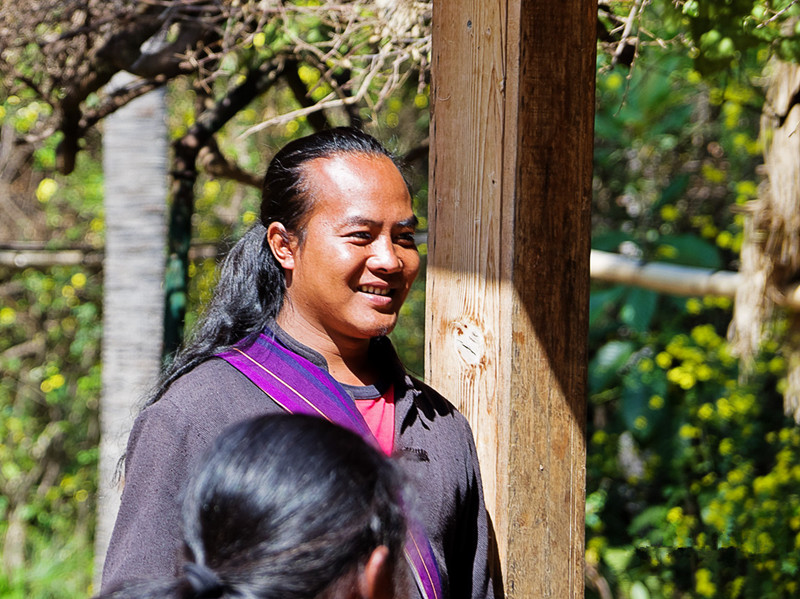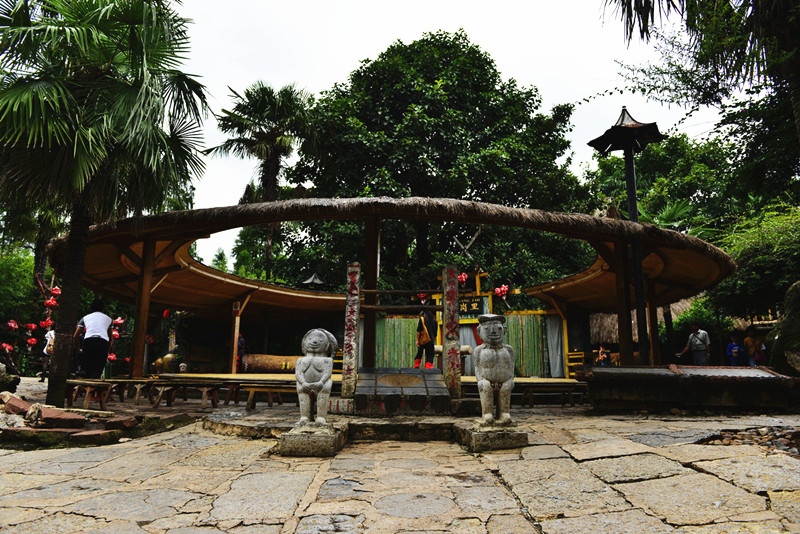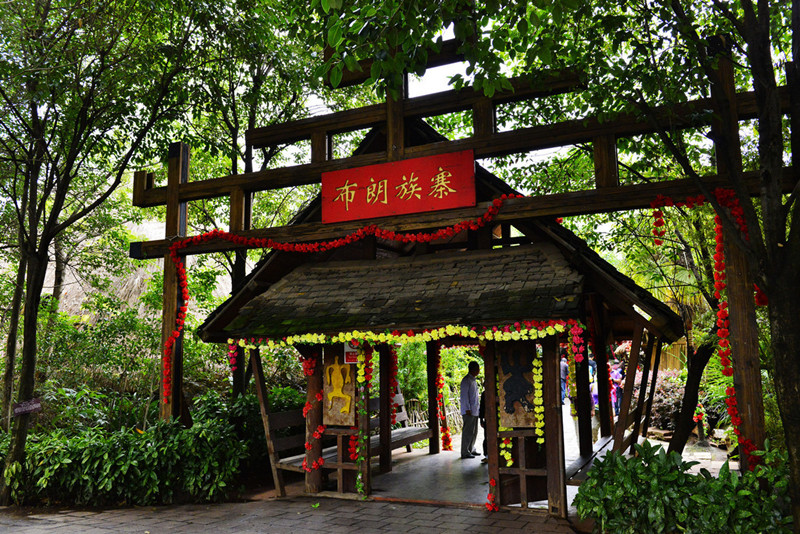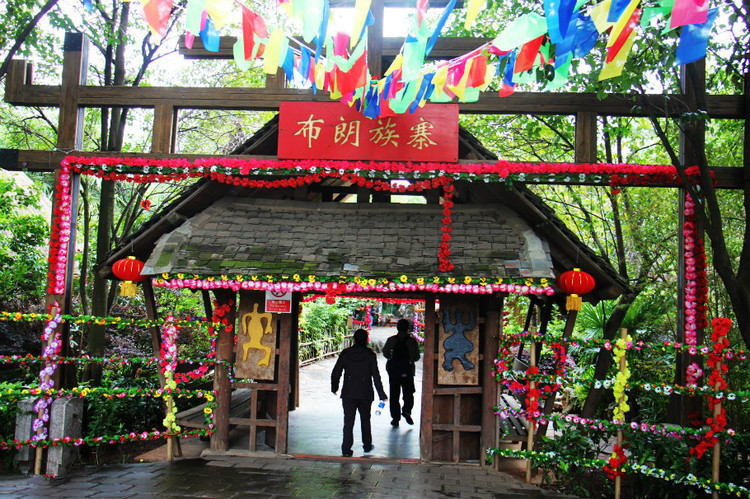
Village of Bulang Ethnic Minority in Yunnan Ethnic Villages, Kunming
Location and Overview
The Village of Bulang Ethnic Minority is located within Yunnan Ethnic Villages in Xishan District, Kunming, on 1310 Dianchi Road (云南省昆明市西山区滇池路1310号). This scenic area is dedicated to showcasing the rich cultural heritage of the Bulang people (布朗族), one of Yunnan’s ethnic minorities. Surrounded by lush forests and abundant vegetation, the village offers a serene and picturesque environment, embodying the Bulang people’s deep connection to nature.
The Bulang ethnic group, with a long history and unique customs, speaks the Bulang language, which belongs to the Mon-Khmer branch of the Austroasiatic language family. While they have their own language, the Bulang people do not have a written script. The village features traditional architectural styles, such as stilt houses (干栏式民居), which are often two stories high. The lower floor is used for storage, while the upper floor serves as the living space, reflecting the ingenuity of the Bulang people in adapting to their environment.
Attractions within the Village
Ghost and Spirit Plaza (鬼神广场)
One of the key features of the Bulang village is the Ghost and Spirit Plaza, a sacred space where the Bulang people worship their deities and pray for happiness. In the center of the plaza stands the village’s totem, surrounded by stones engraved with images of the Bulang’s animal totems, the bamboo rat and toad (竹鼠和癞蛤蟆). These symbols reflect the Bulang belief in animism, the idea that all things in nature possess a spiritual essence. The plaza also serves as an important location for traditional performances, dances, and cultural activities, offering visitors a chance to experience the Bulang people’s vibrant customs.
Traditional Architecture
The village is home to several unique buildings, including stilt houses and community structures. These include:
- Traditional Stilt Houses (干栏式民居): These two-story homes are made of bamboo, with the lower floor used for storage and the upper floor for living, providing an authentic glimpse into the Bulang way of life.
- Totem Statues (图腾雕像): The village totem is prominently displayed in the plaza, representing the deep cultural and spiritual beliefs of the Bulang people.
Cultural Practices
The Bulang people have a rich oral tradition, and their culture is expressed through songs, dances, clothing, and customs. The village offers visitors opportunities to witness traditional Bulang performances, including:
- Traditional Songs and Dances: The Bulang people are known for their music and vibrant dances, which often take place in the Ghost and Spirit Plaza.
- Festivals: The Bulang celebrate numerous traditional festivals, such as their New Year, known as Sang Kan Bi Mai (桑衎比迈), which takes place in mid-June of the Dai calendar (around mid-April in the Gregorian calendar). The celebration lasts three days and includes activities like water splashing (泼水), sand piling (堆沙), and flower decorating (插花), depending on the region.
Cultural Insights
Bulang Language and Traditions
The Bulang people are a unique ethnic group primarily found in the western and southern parts of Yunnan, particularly in the mountainous areas along the lower reaches of the Lancang River (澜沧江). Their language belongs to the Mon-Khmer family, with two main dialects: Bulang and Ava (阿瓦). Despite not having a written script, the Bulang people have preserved their culture through oral traditions.
The Bulang people have a close relationship with the neighboring Wa people (佤族), with whom they have shared a long history of peaceful coexistence and mutual assistance. This relationship is reflected in the architecture of the Yunnan Ethnic Villages, where the Bulang and Wa villages are located adjacent to each other.
Animism and Religious Beliefs
Animism plays a central role in Bulang spirituality. They believe that spirits inhabit all aspects of nature, from animals to plants, and that unseen forces influence the well-being of their people. This belief is evident in their frequent ceremonies to honor spirits and seek their blessings for protection and prosperity. The bamboo rat and toad are among the most revered totems, symbolizing the connection between the natural and spiritual worlds.
Tea Culture
One of the Bulang people’s most cherished traditions is their tea culture. Bulang tea is renowned for its rich flavor, particularly their method of roasting tea leaves (烤茶). The leaves are placed in a special tea pot and roasted over an open flame. Once the tea releases a fragrant aroma, boiling water is added to brew a rich and aromatic drink. This roasted tea is considered the finest offering for guests and is a symbol of Bulang hospitality.
Festivals and Celebrations
Sang Kan Bi Mai (桑衎比迈) – Bulang New Year
The most significant festival for the Bulang people is their New Year, celebrated in mid-April. The festival is called Sang Kan Bi Mai, which translates to “New Year in June.” In Xishuangbanna (西双版纳), the Bulang New Year is celebrated with water-splashing festivities, similar to the Water-Splashing Festival (泼水节) of the Dai people. In other regions, such as Lincang (临沧), the festival is marked by building sand piles and decorating them with flowers, giving it the names “Sand Piling Festival” (堆沙节) or “Flower Decorating Festival” (插花节).
During the celebrations, Bulang families come together to perform ritual bathing ceremonies, clean family altars, and participate in community dances and feasts. The festivities are a time to honor their ancestors and celebrate the renewal of life.
The Village of Bulang Ethnic Minority in Yunnan Ethnic Villages offers visitors an immersive experience of the Bulang people’s rich history, unique architecture, spiritual beliefs, and vibrant cultural practices. From the peaceful Ghost and Spirit Plaza to the lively festival celebrations, the village provides a rare glimpse into the life of one of Yunnan’s most distinctive ethnic groups. Visitors can explore the traditions that have shaped the Bulang people’s identity for generations while enjoying the natural beauty and cultural heritage preserved in this picturesque village.





 7 Days GolfingTour
7 Days GolfingTour
 8 Days Group Tour
8 Days Group Tour
 8 Days Yunnan Tour
8 Days Yunnan Tour
 7 Days Shangri La Hiking
7 Days Shangri La Hiking
 11 Days Yunnan Tour
11 Days Yunnan Tour
 6 Days Yuanyang Terraces
6 Days Yuanyang Terraces
 11 Days Yunnan Tour
11 Days Yunnan Tour
 8 Days South Yunnan
8 Days South Yunnan
 7 Days Tea Tour
7 Days Tea Tour
 8 Days Muslim Tour
8 Days Muslim Tour
 12 Days Self-Driving
12 Days Self-Driving
 4 Days Haba Climbing
4 Days Haba Climbing
 Tiger Leaping Gorge
Tiger Leaping Gorge
 Stone Forest
Stone Forest
 Yunnan-Tibet
Yunnan-Tibet
 Hani Rice Terraces
Hani Rice Terraces
 Kunming
Kunming
 Lijiang
Lijiang
 Shangri-la
Shangri-la
 Dali
Dali
 XishuangBanna
XishuangBanna
 Honghe
Honghe
 Kunming
Kunming
 Lijiang
Lijiang
 Shangri-la
Shangri-la
 Yuanyang Rice Terraces
Yuanyang Rice Terraces
 Nujiang
Nujiang
 XishuangBanna
XishuangBanna
 Spring City Golf
Spring City Golf
 Snow Mountain Golf
Snow Mountain Golf
 Stone Mountain Golf
Stone Mountain Golf
















